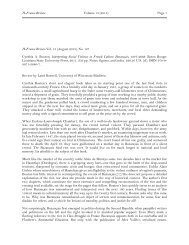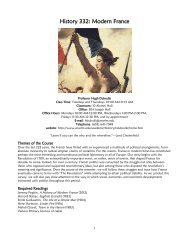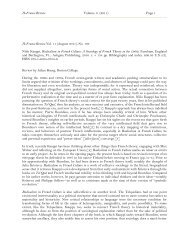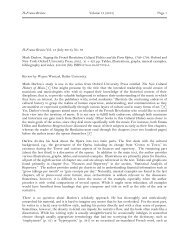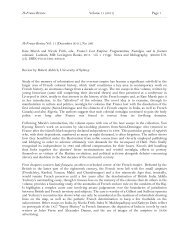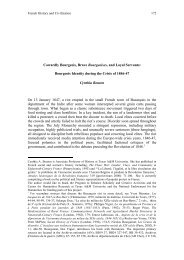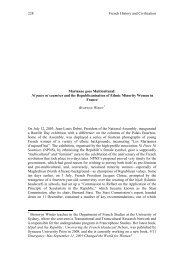Review - H-France
Review - H-France
Review - H-France
Create successful ePaper yourself
Turn your PDF publications into a flip-book with our unique Google optimized e-Paper software.
H-<strong>France</strong> <strong>Review</strong> Volume 7 (2007) Page 79<br />
the dossiers of the administrateurs provisoires and biens aryanisés is not the gross mistreatment they<br />
describe. Rather, it is the tone of bureaucratic normality pervading the documents” (p. 188).<br />
The comprehensive approach operates in the particular sections as well as in the overall narrative. His<br />
cultural history meshes material and popular culture. In the opening chapter on hairdressing before the<br />
First World War, this reader (who fancies herself a women’s historian and a fashion historian) learned<br />
that the massive hairstyles of nineteenth-century ladies required many hairpieces made from human hair<br />
purchased from a world market in “raw hair” centered, in <strong>France</strong>, at the Limoges Bourse aux Cheveux.<br />
Heads full of curls on grandes dames or grandes horizontales required daily professional upkeep in their<br />
homes, not in salons. The trend toward smaller, simpler hairstyles in the early twentieth century takes<br />
on a whole new meaning in light of the time and effort involved in those earlier hairstyles.<br />
Of course, Zdatny addresses the “hot” topics of modernity and the modern woman. The discussion of<br />
modernity in hairdressing is brief, revealing that there was a battle between the classicists (elaborate<br />
styles) and the modernists (simpler styles) among hairdressers. An entire chapter is devoted to “The<br />
Bob,” the short haircut that aroused so much controversy in the 1920s. After due attention to the<br />
cultural commotion over the bob as a sign of sexual confusion, Zdatny identifies how hairdressers and<br />
their customers softened and thereby feminized their new cuts by applying permanent waves. From the<br />
owners’ point of view, this had several advantages: more women than ever before went to the salons,<br />
where they paid three hundred or more francs for perms. More generally, as Zdatny states, “The<br />
significance of the bob thus lay not in a particular length or shape of hair, but in the collapse of the old<br />
social frontiers of fashion” (p. 71).<br />
Another methodological mix in Fashion, Work and Politics is labor and gender approaches. In the late<br />
nineteenth century, we learn, hairdressing was ninety percent male, with men serving both as barbers<br />
for men and as hairdressers for women. At that time it was among the poorest trades, in terms of<br />
overcrowding, wages (lower than those of the average male laborer), and working conditions. Aside<br />
from working eighty to ninety hours per week and more than 300 days a year, hairdressers suffered<br />
from a variety of occupational illnesses like eczema, asthma, varicose veins, and tuberculosis as new<br />
technologies brought new toxins into the small and usually poorly ventilated salons. During and after<br />
the First World War, when the trade lost almost ten percent of its workforce, women moved into the<br />
salons as workers and as owners. Entering the occupation in a time of war and simplified hairstyles,<br />
many women did not get any training in the previously lucrative skills of making postiches (the main<br />
type of hairpiece for women). Although Zdatny does not make the point, this pattern of entry into less<br />
skilled work paralleled developments in retail clerking and office work. However, he notes that the<br />
continuing influx of women coincided, not with decline, as many labor historians argue, but rather with<br />
prosperity, at least until the depression.<br />
The chapters on organization of the employers and workers read like the more traditional labor<br />
histories, listing unions, federations, splits between federations, and strikes, enlivened by identifying and<br />
following the trajectory of a few union leaders. The largely male unionized workers engaged in many<br />
strikes to get the forty hour week and English weekend, though they at best obtained fifty-two to fiftyseven<br />
hour weeks (the difference reflecting Paris versus the provinces). Zdatny recognizes that “A twoday<br />
strike involving fifty barber assistants…. probably does not rise to the level of national drama. Yet<br />
it has something important to teach us about working life and social reform in the early Third Republic”<br />
(p. 50).<br />
Ultimately, probably the most positive feature of Fashion, Work and Politics in Modern <strong>France</strong> is linking<br />
the apparently frivolous topic of hairdressing with undeniably serious developments in economic and<br />
political history. For instance, Zdatny connects the growing practice of wet- (as opposed to dry-)<br />
washing women’s hair with provision of municipal and household utilities, such as a public water supply<br />
and hot running water, as well as the development and marketing of shampoos. Similarly, he links



